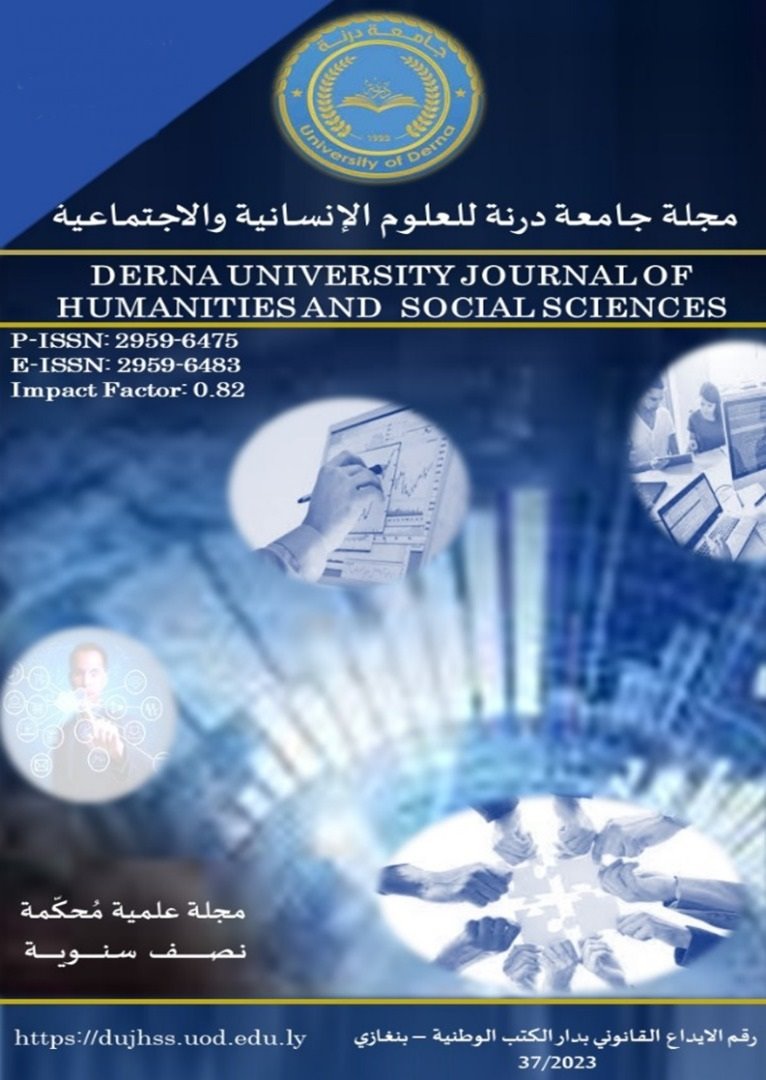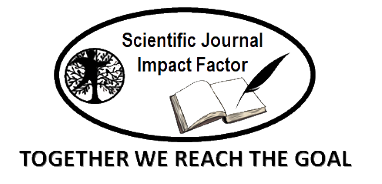العلاقة بين أدوات السياسة النقدية والتضخم في ليبيا دراسة قياسية عن الفترة (1990-2020)
Keywords:
Inflation, Monetary policy, ARDLAbstract
The study aimed to identify the relationship between monetary policy tools and inflation in Libya, by evaluating the impact of monetary policy and its variables: exchange rate, bank credit granted to the private sector, and money supply on inflation rates in Libya during the period (1990-2020). The study followed the ARDL methodology in analyzing the relationship between inflation and each of the exchange rate, money supply, and the volume of credit granted. The study concluded that there is an inverse relationship between inflation and the exchange rate. The results also showed a direct relationship between inflation and money supply, as well as a relationship between inflation and credit granted to the private sector. The study recommends the importance of having compatibility between economic policies to achieve economic goals, including addressing the problem of inflation, working on further reforms in the banking sector, and enhancing the independence of the Central Bank.
References
1- سامي ساسي، يوسف مسعود، (2014). اختبار العلاقة السببية بين أسعار الصرف والمستوى العام للأسعار -دراسة تطبيقية على الاقتصاد الليبي خلال الفترة 1993-2014، مجلة العلوم الاقتصادية والسياسية، كلية الاقتصاد والتجارة، الجامعة الأسمرية، زليتن، ص1-32.
2- أبو عزوم عبدالرحيم، محمد سعيد، (2016). أثر السياسات المالية والنقدية على معدلات التضخم في الاقتصاد الليبي خلال الفترة 21010-2014، كتاب: ندوة الأزمة الاقتصادية والمالية في الاقتصاد الليبي التحديات وسياسات الإصلاح المطلوبة، كلية الزراعة وكلية الاقتصاد والمحاسبة، سبها ، ص42-61.
3- محمود عنبر، سمر الباجوري، تأثير السياسة النقدية على معدل التضخم في مصر خلال الفترة 1981-2019- دراسة قياسية، المجلة العلمية لكلية الدراسات الاقتصادية والعلوم السياسية، جامعة الإسكندرية، م (9)، ع(17)، ص59-88.
4- عبد المطلب عبد الحميد. (2016). الأساسيات في المصارف التجارية، الطبعة الثانية. الدار الجامعية. ص 177-180.
5- محمد صالح الحناوي. (2015). الإدارة المالية للبنوك، الطبعة الرابعة. الدار الجامعية.
6- سمير رضوان. (2018). إدارة البنوك، الطبعة السادسة. دار النهضة العربية.
7- محمد السيد عابد، (2018). الاقتصاد الدولي ،الطبعة السادسة، دار الجامعة الجديدة.
8- -جمال الدين زروق، (2015). الاقتصاد الدولي، الطبعة الثالثة، دار المريخ للنشر.
9- محمد عرفات مطر، (2017). الاقتصاد الدولي، الطبعة الخامسة، دار الجامعة الجديدة.
10- الطاهر لطرش، (2015). الاقتصاد النقدي والبنكي، ديوان المطبوعات الجامعية، الجزائر، الطبعة الثانية.
11- جميلة وجدي، بودي نعيمة، (2019). السياسة النقدية واستهداف التضخم، مجلة المشكاة في الاقتصاد والتنمية، الجزائر، 2019 العدد 10.
12- محمد عبدالعاطي، الشرقاوي، (2019). الاقتصاد الكلي: النظرية والسياسة، القاهرة: دار النشر العربي.
13- عبدالمجيد قريشي، (2018). مبادئ الاقتصاد الكلي، القاهرة: دار العلوم الاقتصادية
14- عبد الصمد سعودي، (2018). الاقتصاد النقدي وأسواق رأس المال، عمان، الأردن، الطبعة الأولى.
15- Elabbar, A. A., & Shamia, A. A. (2022). The Impact of Exchange Rate and Money Supply on Inflation in Libya. Journal of Economic and Administrative Sciences, 38(1), 78-97. https://doi.org/10.1108/JEAS-03-2020-0032
16- Abuhadra, D. S., & Bouri, A. (2015). The Impact of Money Supply and Credit on Inflation in Libya. Journal of Economic and Social Studies, 5(1), 139-154. https://doi.org/10.14706/JECOSS15514
17- Bashir, M. F., & Abdalla, S. J. (2018). The Determinants of Inflation in Libya: An Empirical Analysis. International Journal of Economics and Financial Issues, 8(3), 92-98. https://www.econjournals. com/index.php/ijefi/ article/view/6270
18- Choudhry, T. (1995). High inflation rates and the long-run money demand function: evidence from cointegration tests. Journal of Macroeconomics, 17(1), 77-91. https://doi.org/10.1016/0164-0704(95) 80025-3
19- Catão, L. A., & Terrones, M. E. (2005). Fiscal deficits and inflation. Journal of Monetary Economics, 52(3), 529-554. https://doi.org/10.1016/ j.jmoneco. 2004.06.003
20- . Loungani, P., & Swagel, P. (2001). Sources of inflation in developing countries. IMF Working Paper, 01/198. https://www.imf.org/ external/pubs/ft/wp/2001/ wp01198.pdf
21- Khan, M. S., & Schimmelpfennig, A. (2006). Inflation in Pakistan: money or wheat? IMF Working Paper, 06/60. https://www.imf.org/external/ pubs/ft/wp/ 2006/wp0660.pdf
22- Nguyen, T. Q., & Nguyen, C. V. (2020). Determinants of Inflation in Vietnam: A Comprehensive Approach. Emerging Markets Finance and Trade, 56(3), 589-605.
23- Keho, Y. (2019). What Drives Inflation in Sub-Saharan African Countries? Journal of Economic Studies, 46(3), 564-577.
24- Bittencourt, M., & Chang, S. (2019). Institutional Quality, Macroeconomic Performance and the Determination of Inflation in Latin America. Empirical Economics, 57(4), 1255-1275.
25- Sakr, A., Mendoza, M. A., & Fouad, A. (2021). Determinants of Inflation in Egypt: An Econometric Analysis Using the Vector Error Correction Model. Journal of Economic and Financial Research, ISSN 2314-7245.
26- Al-Anzi, S., Al-Khader, K., & Al-Rashidi, F. (2020). Determinants of Inflation in Kuwait: An Analysis Using Dynamic Panel Data Models. Arab Journal of Administration, ISSN 1110-8703.
27- Al-Khathlaan, A. (2019). Determinants of Inflation in Saudi Arabia: An Econometric Analysis. Journal of Economics and Management, King Saud University, ISSN 1018-3639.
28- Dornbusch, R., Fischer, S., & Startz, R. (2018). Macroeconomics (12th ed.). McGraw-Hill Education.
29- Mankiw, N. G. (2020). Principles of Economics (8th ed.). Cengage Learning.
30- Mishkin, F. S. (2016). The Economics of Money, Banking, and Financial Markets (11th ed.). Pearson.
31- Pesaran, M. H., Shin, Y., & Smith, R. J. (2001). Bounds testing approaches to the analysis of level relationships. Journal of Applied Econometrics, 16(3), 289-326.
32- Froot, K. A., & Rogoff, K. (1995). Perspectives on PPP and long-run real exchange rates. Handbook of international economics, 3, 1647-1688.
33- Friedman, M. (1968). The role of monetary policy. The American economic review, 58(1), 1-17.
34- Mankiw, N. G. (2020). Principles of Economics (8th ed.). Cengage Learning.
35- McCandless, G. T., & Weber, W. E. (1995). Some monetary facts. Federal Reserve Bank of Minneapolis Quarterly Review, 19(3), 2-11.
36- Obstfeld, M., & Rogoff, K. (1996). Foundations of international macroeconomics. MIT press.
37- Rogoff, K. (1996). The purchasing power parity puzzle. Journal of Economic literature, 34(2), 647-668.
38- Mishkin, F. S. (2019). The Economics of Money, Banking, and Financial Markets (12th ed.). Pearson.
39- Mankiw, N. G. (2020). Principles of Economics (8th ed.). Cengage Learning.
40- International Monetary Fund. (2022). World Economic Outlook: Countering the Cost-of-Living Crisis. Washington, DC: International Monetary Fund.
41- The World Bank. (2023). Inflation, consumer prices (annual %). Retrieved from https://data.worldbank.org/indicator/FP.CPI.TOTL.ZG



























